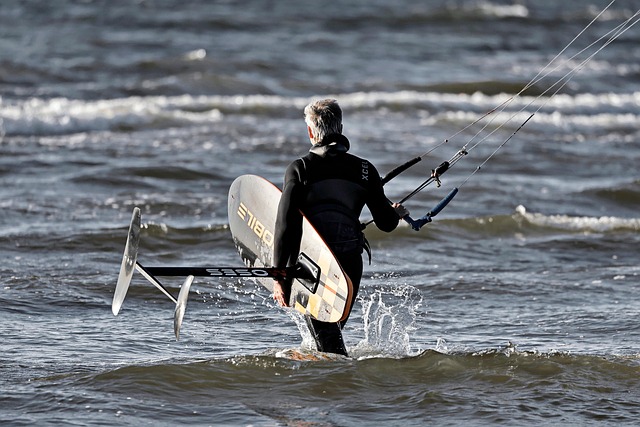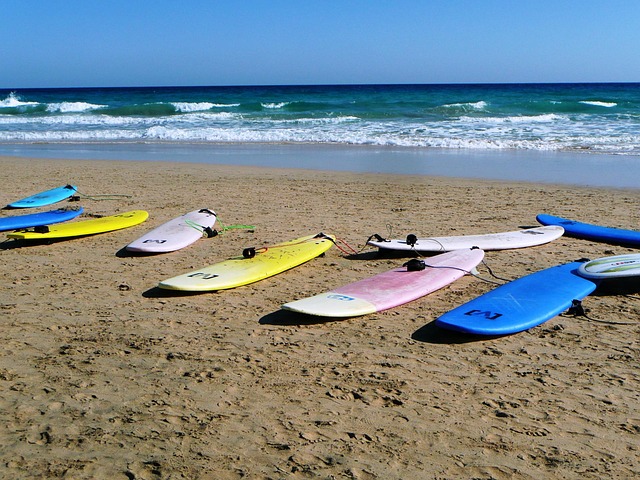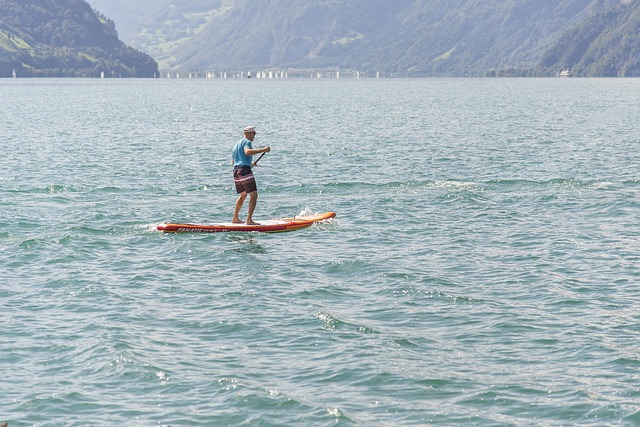Selecting the ideal surfboard is key for novice surfers to enhance their water sports journey. Surfboard shapes have evolved to cater to diverse riding styles and skill levels, with factors like length, width, volume, and tail shape determining performance. Beginners should opt for longer, wider boards (8-10 feet) for stability and floatation, while advanced surfers might choose narrower models (6-7 feet) for speed and agility. Volume affects buoyancy, with higher volumes ideal for small waves. Tail shapes range from rounded to pointed, each suited to specific surfing preferences and wave conditions. Choosing the right board involves considering skill level, preferred style, body weight, and wave type to ensure optimal performance and enjoyment.
For surf enthusiasts, understanding the variety of shapes available can significantly enhance performance. This guide is tailored for beginners seeking to demystify the art of surfboard design. We’ll cover essential aspects like basic shape overview, dimensions’ impact on performance, and unique playing styles tied to different board shapes. From tail shapes enabling maneuverability to the popularity of the fish for newcomers, this article offers insights crucial for selecting your first surfboard. By considering shape and size, beginners can make informed decisions, ensuring a more enjoyable and performant surfing experience.
Understanding Shape Basics: An Overview for Beginners

For beginners in water sports like surfing, understanding the variety of shapes available in surfboards is key to making an informed choice. Surfboard shapes have evolved over time, each design catering to different riding styles and skill levels. The basic components that define a surfboard’s shape include its length, width, volume, and tail shape.
Length, typically measured in feet, dictates the board’s stability and maneuverability. Wider boards offer more floatation and are easier for beginners to stand on, while narrower models provide enhanced speed and agility. Volume, or the amount of space inside the board, influences buoyancy, with higher volumes suitable for smaller wave conditions and beginners. Tail shape varies from rounded (for stability) to pointed (for faster turns), each style suited to different surfing preferences and wave types. Choosing the right surfboard shape for your skill level and desired performance can significantly enhance your learning experience and overall enjoyment of the sport.
Surfboard Dimensions: How They Affect Performance

When it comes to choosing a surfboard, dimensions play a significant role in dictating its performance. For beginners looking to ease into the sport, a longer surfboard is often recommended. These boards typically range from 8 to 10 feet (2.4 to 3 meters) and offer greater stability, making them ideal for catching waves with more ease. Longer boards provide a larger surface area to support your weight, which can be particularly beneficial for novice surfers still getting a feel for balance and coordination.
However, as surfers progress and gain experience, they might opt for shorter surfboards, usually between 6 and 7 feet (1.8 to 2.1 meters). These boards offer increased maneuverability and agility, allowing for tighter turns and more dynamic movements in the water. Smaller dimensions enable quicker responses to waves, which is crucial for navigating steeper, faster breaks. Whether a beginner or an advanced surfer, understanding how surfboard dimensions impact performance is key to choosing the right board that complements your skills and desired surfing style.
Common Shapes and Their Unique Playing Styles

In the world of surfing, the variety of shapes available for surfboards is as diverse as the waves themselves. Each design offers a unique playing style catering to different abilities and preferences. For beginners looking to catch their first waves, a surfboard for beginners often features a more rounded nose and broader outline, providing stability and ease of manoeuvre. This design allows new surfers to focus on balance and catching waves without the added complexity of more advanced shapes.
As skills improve, surfers can explore boards with sharper nosedeps and narrower outlines, like fish or gun shapes, which offer greater speed and agility in deeper water. These designs are ideal for tackling faster, more powerful waves, allowing for intricate manoeuvres and carving turns. The variety ensures there’s a surfboard shape to suit every surfer’s style and the conditions they encounter.
Tail Shapes: The Key to Maneuverability

Surfboards, especially those designed for beginners, come in a variety of tail shapes that significantly impact their maneuverability. The fin or tail is a crucial component, as it dictates how the board cuts through the water and responds to rider input. For instance, a rounded square tail offers enhanced stability, making it ideal for learning to catch waves. On the other hand, a more pointed tail shape provides better speed and agility, suitable for experienced surfers looking to perform tighter turns and maneuvers.
These tail shapes play a pivotal role in how the surfboard handles different conditions and surfing styles. For beginners, a fuller tail design can help maintain balance and predictability, enabling them to focus on mastering the basics of paddling and catching waves. As skill levels advance, many surfers opt for more refined tails that allow for increased speed and dynamic maneuvers, making their surfboard an extension of their desired performance.
Rocking the Fish: Benefits for New Surfers

For new surfers, choosing the right surfboard can make all the difference in their learning experience. One unique option gaining popularity is the “rocking fish” design, a surfboard shaped to mimic the fluid movements of a fish. This style offers several advantages for beginners; its wider nose and tail provide better stability, making it easier to balance and catch waves. The rockering (or flex) in the board allows for smoother turns and helps surfers get up to speed faster, reducing the learning curve associated with traditional boards.
Additionally, the rocking fish design is often more forgiving on smaller or weaker waves, encouraging new surfers to gain confidence and improve their skills. This type of surfboard can be an excellent choice for those taking their first strides in surfing, offering a blend of playfulness and stability that promotes a fun and engaging learning environment.
Longboards vs. Shortboards: A Shape-Based Comparison

When it comes to choosing a surfboard, one of the key considerations is its shape, which significantly impacts performance. For beginners, understanding the differences between longboards and shortboards can be a game-changer. Longboards, as the name suggests, are longer and wider, offering increased stability and flotation. Their larger surface area makes them ideal for learning to catch waves, as they provide a more forgiving platform for balancing and paddling.
On the other hand, shortboards are sleek, narrower boards that require a bit more skill and experience to handle. They are designed for speed and agility in tight turns and are often preferred by advanced surfers. The reduced surface area makes them more responsive but also less stable, demanding better control and timing from the surfer. For beginners, starting with a longboard is recommended as it fosters a stronger connection with the water and encourages proper technique before progressing to more challenging shapes like shortboards.
Choosing Your First Board: Consideration of Shape and Size

When selecting your first surfboard, one of the most crucial decisions is choosing the right shape and size, as this significantly impacts your learning experience. For beginners, it’s often best to start with a board that offers stability and ease of control. Typically, longer boards like 8-foot or 9-foot longboards are ideal because they provide better balance and buoyancy, making it easier to catch waves and practice basic maneuvers.
The shape of the surfboard also plays a vital role in its performance. For instance, a pin tail design offers enhanced maneuverability while still providing stability. Alternatively, wider boards offer more floatation, which is beneficial for beginners learning to paddle out and stand up on the wave face. Consider your body weight, surfing ability, and the type of waves you’ll be riding when making this decision, ensuring the surfboard shape and size align with your goals and skill level.
